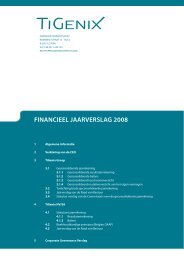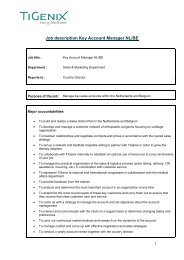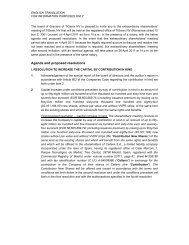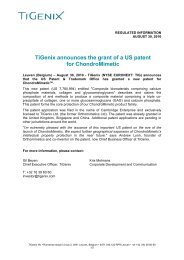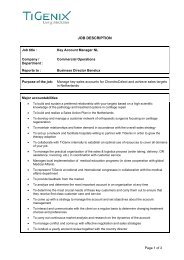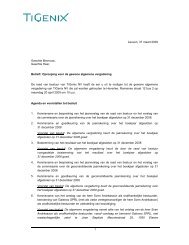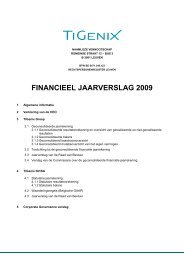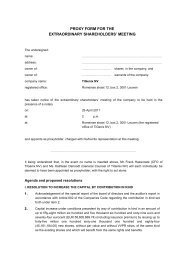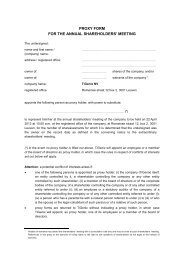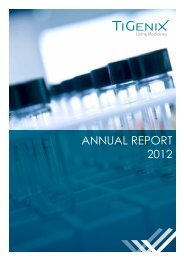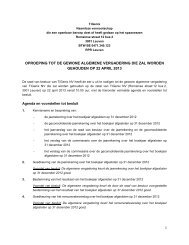ANNUAL FINANCIAL REPORT 2010 2010 - TiGenix
ANNUAL FINANCIAL REPORT 2010 2010 - TiGenix
ANNUAL FINANCIAL REPORT 2010 2010 - TiGenix
- No tags were found...
Create successful ePaper yourself
Turn your PDF publications into a flip-book with our unique Google optimized e-Paper software.
Fig. 6.3: Global Market OpportunityMeniscus damageThe meniscus is a semi-lunar shaped fibro-cartilaginous tissuelocated in the knee and plays a critical role in shock absorption,load distribution, lubrication and stability. Meniscus defectsare among the most frequently encountered injuries inorthopaedic practice. Each year, more than 2 million surgicalinterventions are performed on meniscal tears in Europeand the U.S.Meniscus defects can occur at all ages, in young patient as aresult of sports or work related trauma or in later age resultingfrom even trivial injuries (worn-out meniscus) 22 . The internalsection of the meniscus located inside the joint area is avascularand lesions in this region have a very limited capacity forhealing leading thereby to persisting symptoms and furtherdegeneration of the meniscus. The current therapeuticstrategy for such meniscus tears is essentially partial or totalmeniscectomy, depending on the dimensions of the tear.Although offering an excellent short-term reduction andelimination of clinical symptoms, total meniscectomy inevitablyleads to an increased local and focal pressure in the joint (upto 3 fold normal), resulting in damage of the articular cartilage,degeneration of the joint and ultimately to the development ofosteoarthritis 23 . The present clinical goal therefore is to preserveas much of the meniscus as possible and only remove damagedsections by arthroscopy. While this results in an improvement22 Extrapolated number for the US and EU in 2004. Souces:RIZIV (Belgium),Prismant (The Netherlands) & American Academy of Orthopedic SurgeonsResearch Department.23 Englund M., Meniscal tear--a feature of osteoarthritis, Acta Orthop ScandSuppl. 2004 Apr;75(312):1-45.over full resection of the meniscus, long-term load bearing andload distribution capacity remains compromised and stresseson the local articular cartilage continue to increase. This stillleads to a high incidence of arthritic changes, a high rate ofre-operation and a relatively low functional outcome score. 24Alternative treatment options include suturing or replacementof the tissue, frequently using biodegradable devices orcomplete artificial substitutes, and allograft transplantation.However, these approaches relieve the symptoms but do notprovide a cure. As such failure rates are high 25 , 26 .The challenge for the industry is to develop therapies thatcan result in long-term, durable repair, regeneration andreplacement of damaged or degenerated menisci with a fullrestoration of the biological and mechanical functions of thetissue, to prevent further degeneration of the joint, and tohalt the onset and progression of OA. Based on its extensiveknowledge and expertise in joint and cartilage biology, <strong>TiGenix</strong>believes that cell-based tissue engineering may offer attractivetreatment options for the repair and regeneration of meniscuslesions or for the complete replacement of a degenerated (partof the) meniscus with a tissue engineered construct.24 Hoser C, Fink C, Brown C, Reichkendler M, Hackl W, Bartlett J., Long-termresults of arthroscopic partial lateral meniscectomy in knees withoutassociated damage, J Bone Joint Surg Br. 2001 May;83(4):513-6.25 Noyes FR, Barber-Westin SD., Arthroscopic repair of meniscal tears extendinginto the avascular zone in patients younger than twenty years of age, Am JSports Med. 2002 Jul-Aug;30(4):589-600.26 Frosch KH, Fuchs M, Losch A, Stürmer KM., Repair of meniscal tears with theabsorbable Clearfix screw: results after 1-3 years, Arch Orthop Trauma Surg.2005 Nov;125(9):585-91.113 •



